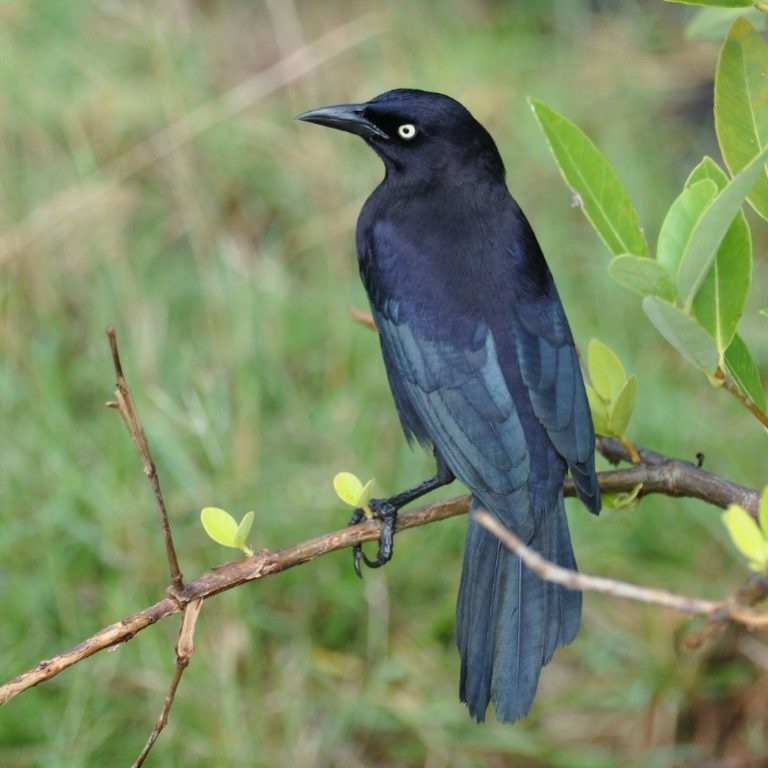Birdfinding.info ⇒ Very common and conspicuous throughout its range. Thrives in human-altered habitats.
Carib Grackle
Quiscalus lugubris
Northern South America and the Lesser Antilles, where it is common to abundant in open, lightly wooded, and settled habitats, including agricultural areas and towns.
In South America, found throughout the Caribbean lowlands and Llanos of Colombia and Venezuela, and more locally eastward through the Guianas to Amapá. Appears to be spreading rapidly south into the intermontane valleys of Colombia and west into Panama.
In the West Indies, found throughout the Lesser Antilles from Anguilla to Trinidad. Also on several of Venezuela’s offshore islands, which account for two of the eight subspecies. Colonized the ABC Islands in the 1980s and ‘90s.
The “Barbados Grackle” is native to Barbados and St. Vincent. It has also been introduced to Antigua, Barbuda, St. Kitts, and Nevis.
Identification
The smallest grackle, with a proportionately shorter tail than the other species. The bill is also shorter, but proportionately thick, often appearing crow-like.
Both tail and bill length vary widely, and the isolated subspecies of Grenada (luminosus) and some Venezuelan islands (insularis and orquillensis) tend to have longer tails and bills than the other subspecies.
As with all grackles, the central tail feathers are the longest, giving the tail a wedge-shaped profile, and it often holds its tail in a “keel” shape (i.e., as a V or U if viewed in cross-section).
Adults of both sexes have pale yellow eyes. Immatures have dark eyes that lighten as they age.

Carib Grackle, Q. l. lugubris, male showing the typical glossy sheen: purplish on the head and body, greenish on the wings and tail. (Arcabuco, Colombia; February 22, 2015.) © F. Calderon
Males of all subspecies are all-black with purplish iridescence on the head and body, and greenish on the wings and tail.
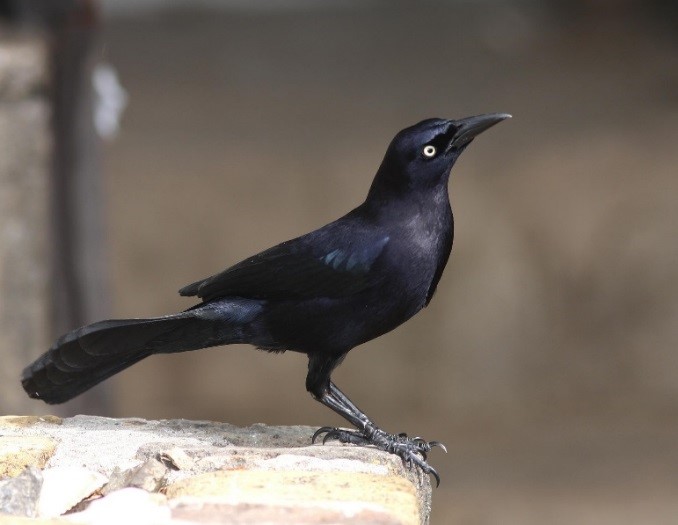
Carib Grackle, Q. l. inflexirostris, male. (Pigeon Island National Park, St. Lucia; April 9, 2011.) © Guy Poisson

Carib Grackle, Q. l. lugubris, male showing wedge-shaped tail. (Venezuela; January 2005.) © Bjorn Svensson
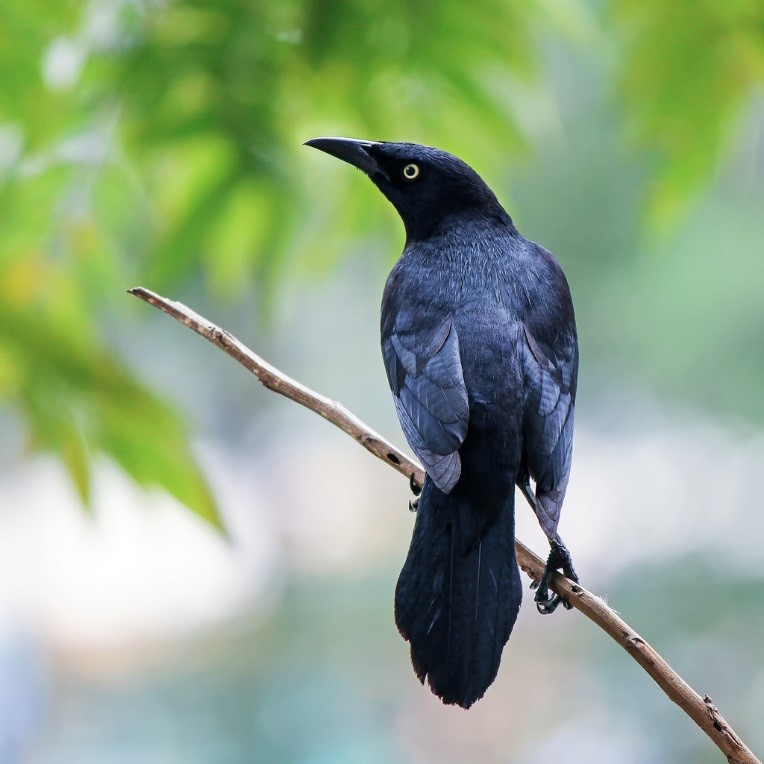
Carib Grackle, Q. l. lugubris, male showing wedge-shaped tail. (Antioquia, Colombia; March 27, 2016.) © Felipe Toro

Carib Grackle, Q. l. inflexirostris, male—note that its bill appears pale blue due to the lighting. (Corinth, St. Lucia; December 29, 2018.) © Tom Younkin
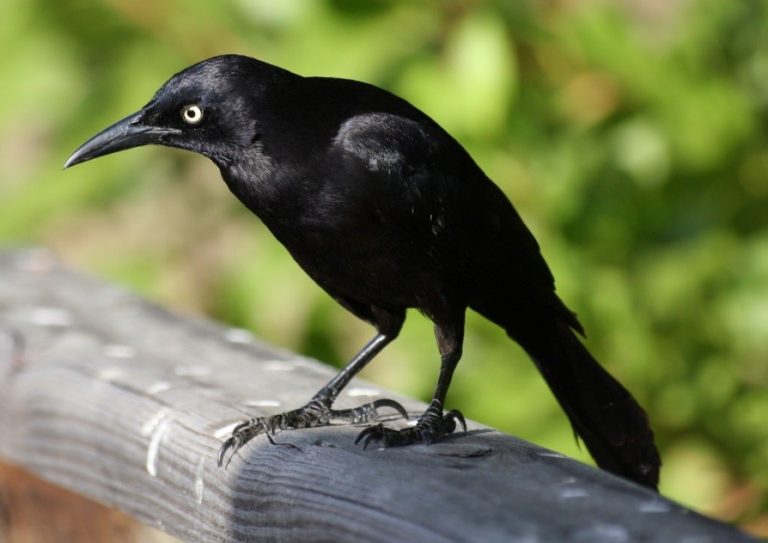
Carib Grackle, Q. l. luminosus, male showing the long bill of this subspecies. (Point Salines, Grenada; March 3, 2010.) © Mark Stevens

Carib Grackle, Q. l. lugubris, male showing crowlike bill shape. (Lorica, Córdoba, Colombia; February 21, 2019.) © José Luis Pérez

Carib Grackle, Q. l. inflexirostris, male displaying. (Anse Cochon, St. Lucia; June 1, 2010.) © Robert Gowan
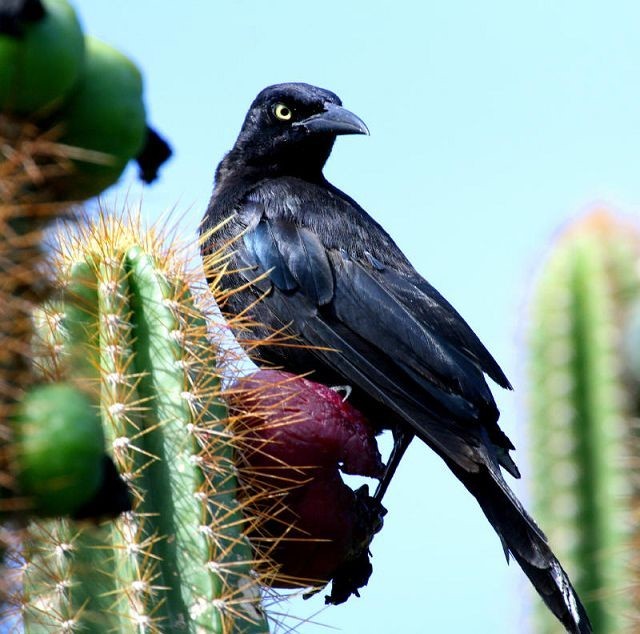
Carib Grackle, Q. l. luminosus, male. (Rutland, Mustique, St. Vincent & the Grenadines; September 6, 2007.) © Rob Speirs

Carib Grackle, Q. l. lugubris, immature male—note that its eye has not yet fully lightened and its tail appears relatively short and narrow. (Maturín, Venezuela; December 30, 2008.) © Phil Gunson

Carib Grackle, Q. l. lugubris, pair. (Tierra del Sol Golf Course, Aruba; October 27, 2007.) © Steven Mlodinow
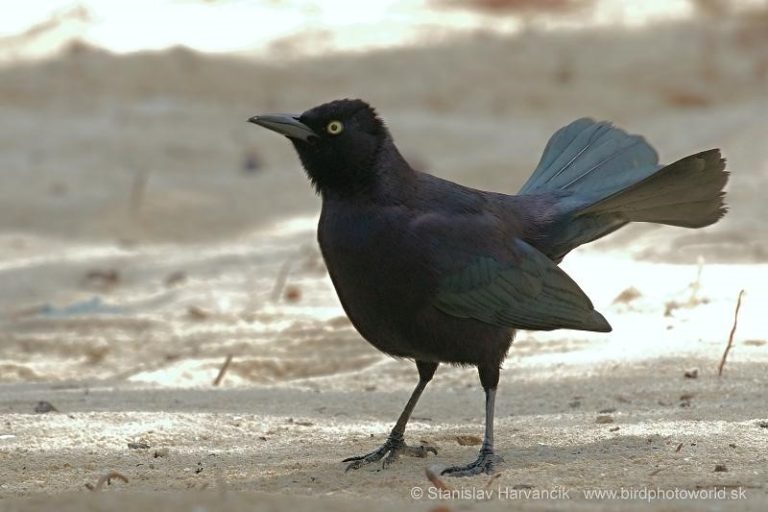
Carib Grackle, Q. l. lugubris, male with tail fanned. (Chichiriviche, Falcón, Venezuela; March 11, 2016.) © Stanislav Harvančik
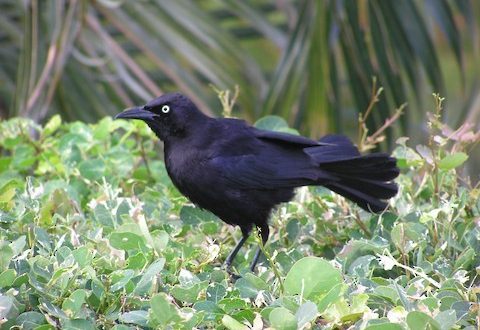
Carib Grackle, Q. l. inflexirostris, male with tail fanned. (Castries, St. Lucia; April 1, 2008.) © James Holmes
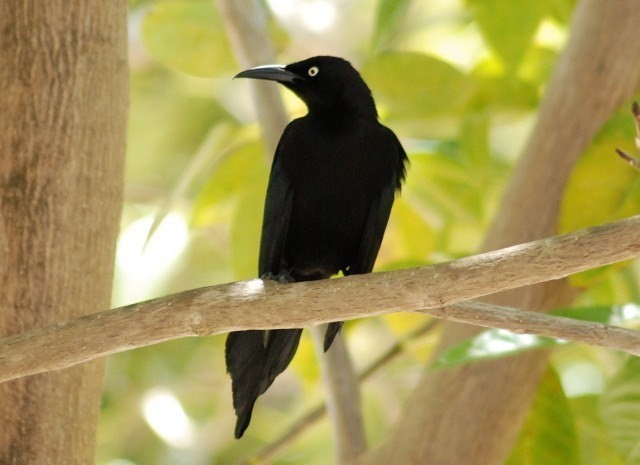
Carib Grackle, Q. l. luminosus, male showing the relatively large bill and long tail of this subspecies. (Prickly Bay, Grenada; April 23, 2009.) © Pat Tucker
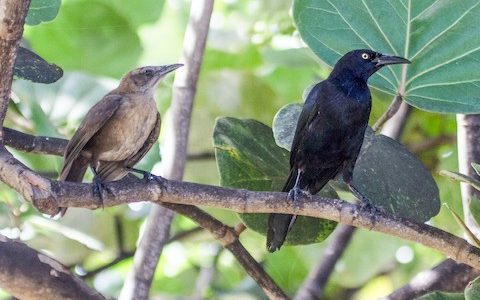
Carib Grackle, Q. l. luminosus, pair. (Levera Beach, St. Patrick, Grenada; July 29, 2013.) © Jeff Gerbracht
Most females are some shade of brown, but the tones and pattern are highly variable. The exception is female “Barbados Grackles,” which are dull black or brownish-black overall.
Females of the widespread nominate subspecies and those of the Venezuelan islands range from pale brown to blackish-brown. Some individuals are evenly colored, but most show a darker mask, pale eyebrow, dark and pale malar streaks, distinctly paler throat, and dark wings and tail.
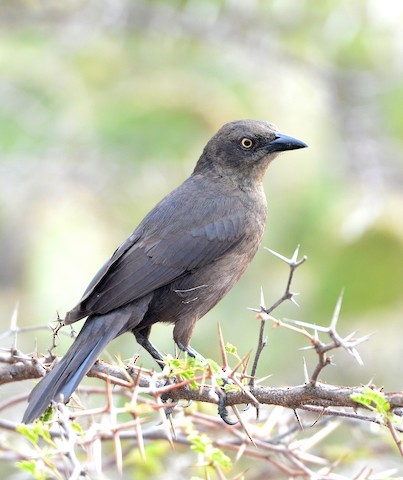
Carib Grackle, Q. l. lugubris, female showing typical coloration. (Bubali Bird Sanctuary, Aruba; April 7, 2013.) © Steven Mlodinow
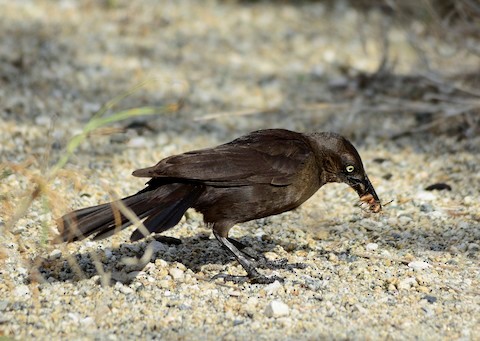
Carib Grackle, Q. l. lugubris, female showing dark coloration. (Bubali Bird Sanctuary, Aruba; August 20, 2017.) © Michael Tromp
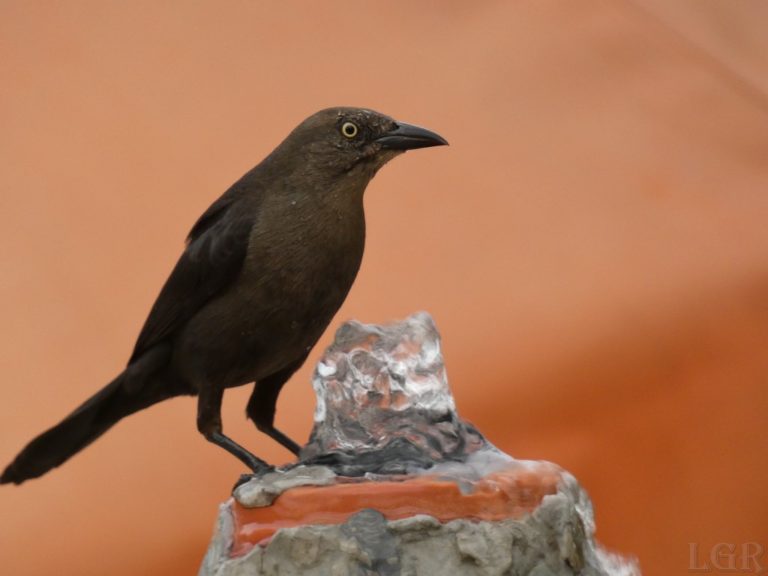
Carib Grackle, Q. l. lugubris, female showing dark coloration, perched on a running fountain. (Valparaíso, Antioquia, Colombia; February 7, 2019.) © Luis G. Restrepo
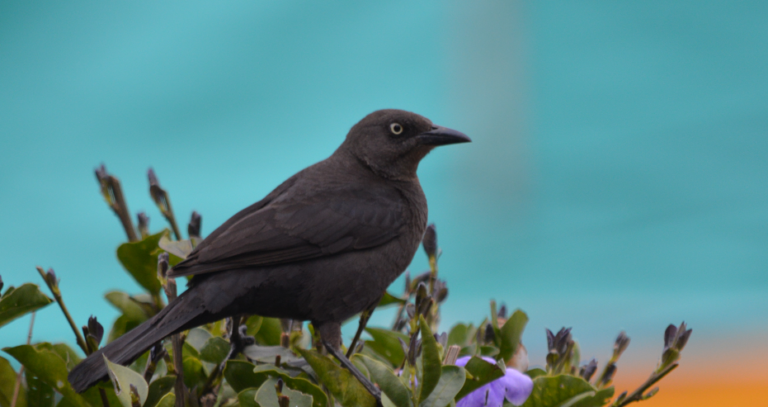
Carib Grackle, Q. l. lugubris, female showing exceptionally dark coloration—but likely exaggerated by the lighting. (Úmbito, Boyacá, Colombia; July 22, 2015.) © oscarperdomo

“Barbados Grackle,” Q. l. fortirostris, female showing blackish-brown coloration—but paler-than-average for this subspecies. (Barbados; April 23, 2009.) © Mikko Pyhälä
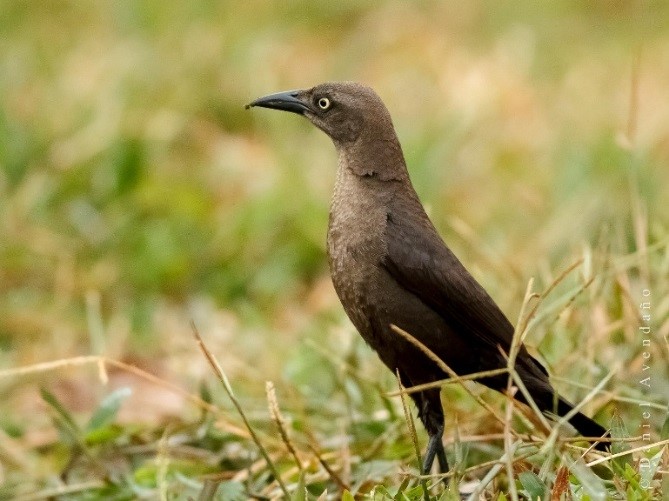
Carib Grackle, Q. l. lugubris, female showing typical coloration. (Norcasia, Colombia; August 8, 2014.) © Daniel Avendaño

Carib Grackle, Q. l. lugubris, female showing pale coloration. (Sasaki Pond, Aruba; December 26, 2017.) © Michael Tromp
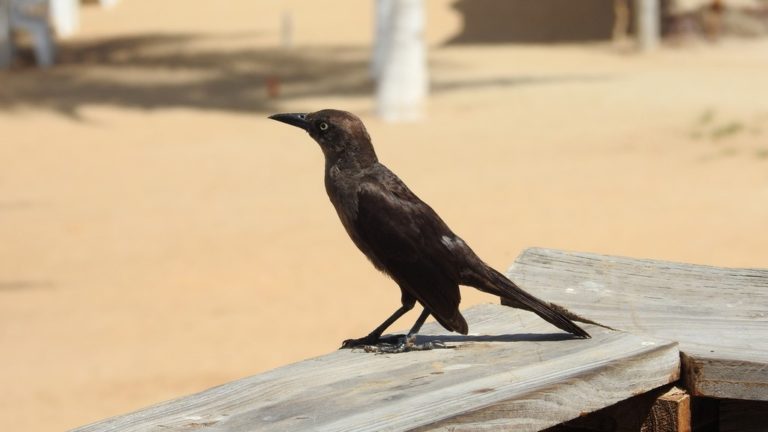
Carib Grackle, Q. l. insularis, female showing dark coloration. (Arismendi, Isla Margarita, Venezuela; July 29, 2016.) © Gerardo Chavarri
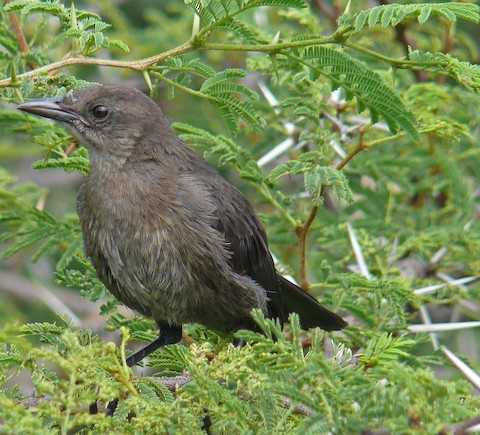
Carib Grackle, Q. l. lugubris, juvenile. (Tierra del Sol Golf Course, Aruba; October 27, 2007.) © Steven Mlodinow
Females of the Lesser Antillean subspecies (other than “Barbados Grackle”) are mostly pale with dark wings and tail, and vary from sandy to medium-brown. Many females of the northernmost subspecies guadeloupensis are pale gray with blackish wings and a strongly defined facial pattern with a pale eyebrow and dark eyeline.
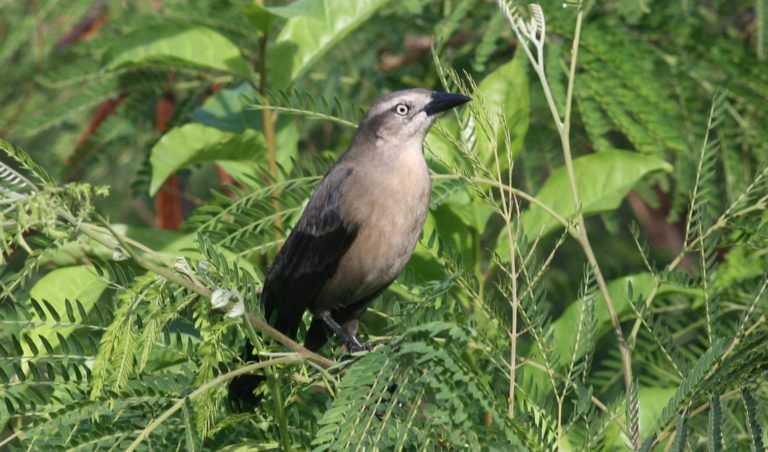
Carib Grackle, Q. l. guadeloupensis, female showing pale underparts, prominent eyebrow, and dark wings and tail. (Simpson Bay, St. Martin; November 18, 2013.) © Kerry Ross
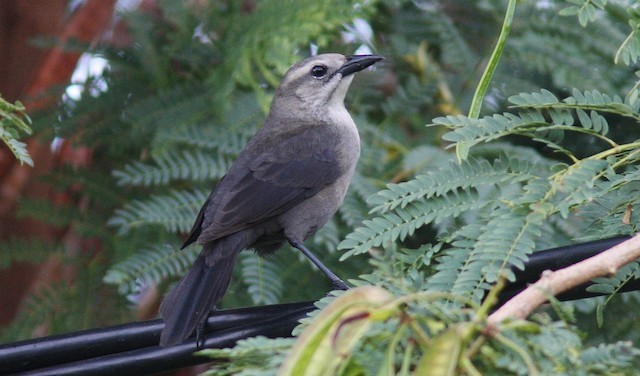
Carib Grackle, Q. l. guadeloupensis, immature female showing grayish coloration, strong facial pattern, and blackish wings and tail. (St. Joseph, Dominica; January 7, 2015.) © Jim Tietz
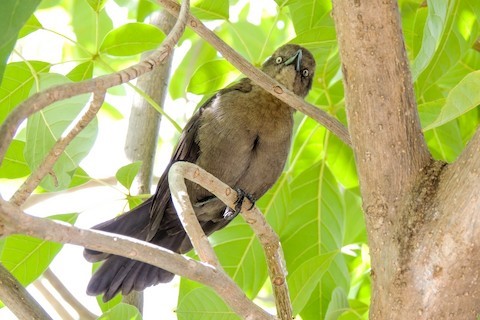
Carib Grackle, Q. l. luminosus, female—note the pale throat and wedge-shaped tail. (St. George, Grenada; January 22, 2014.) © Pat Hare
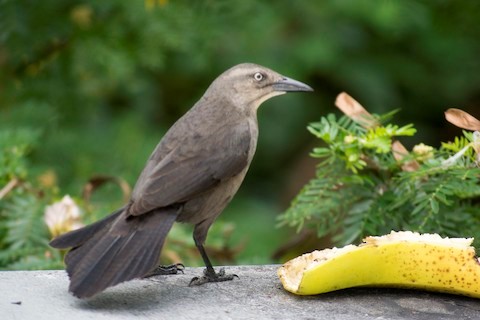
Carib Grackle, Q. l. inflexirostris, female showing wedge-shaped tail. (Grand Riviere, St. Lucia; December 13, 2014.) © Jerome Foster
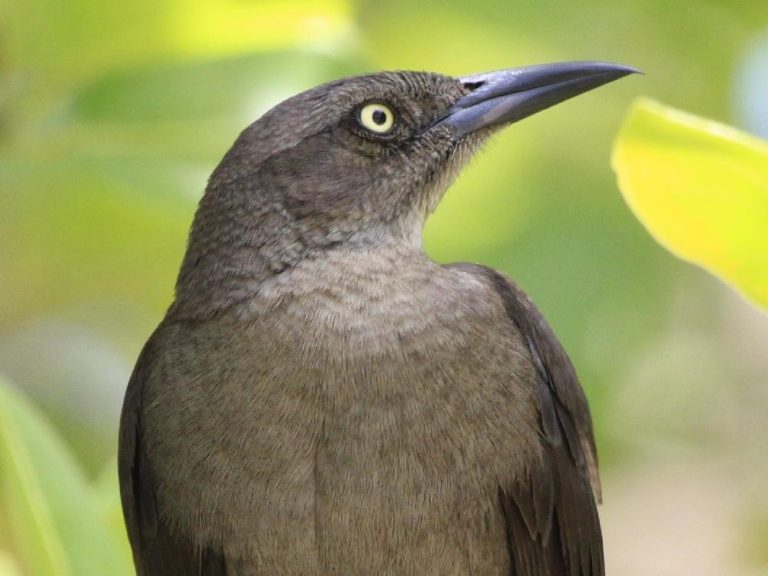
Carib Grackle, Q. l. luminosus, female showing the large bill typical of this subspecies. (Tobago Cays, St. Vincent & the Grenadines; April 9, 2012.) © Christophe Gouraud
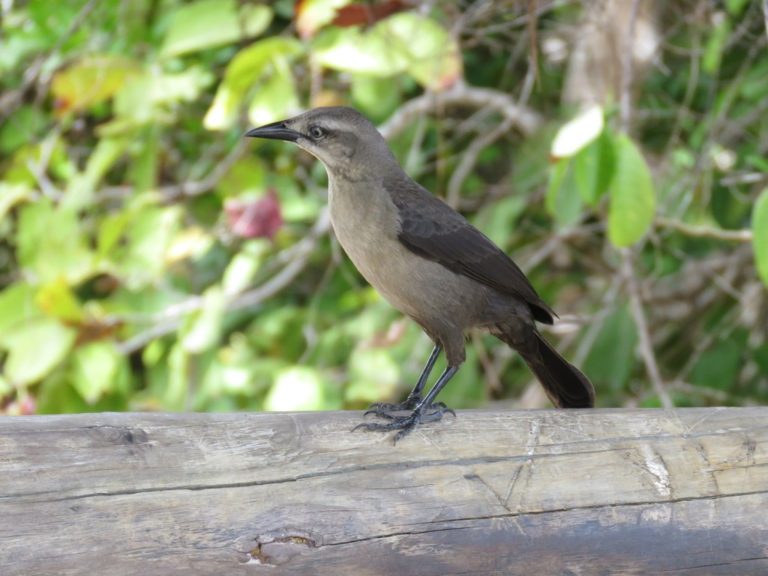
Carib Grackle, Q. l. guadeloupensis, female showing pale underparts, prominent eyebrow, and dark wings and tail. (Caravelle Peninsula Nature Reserve, Martinique; April 6, 2015.) © Mike G. Rutherford

Carib Grackle, Q. l. guadeloupensis, female—an abnormally pale individual. (La Caravelle Nature Reserve, Martinique; December 13, 2017.) © Larry Therrien
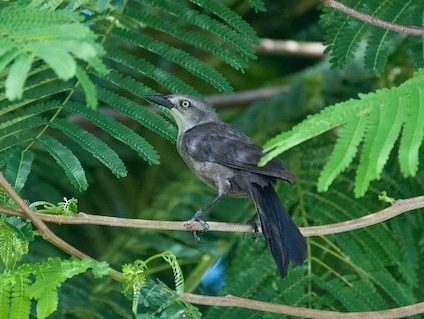
Carib Grackle, Q. l. guadeloupensis, female showing grayish coloration, strong facial pattern, and blackish wings and tail. (Flamingo Beach Resort, St. Martin; July 7, 2017.) © Steven Davies
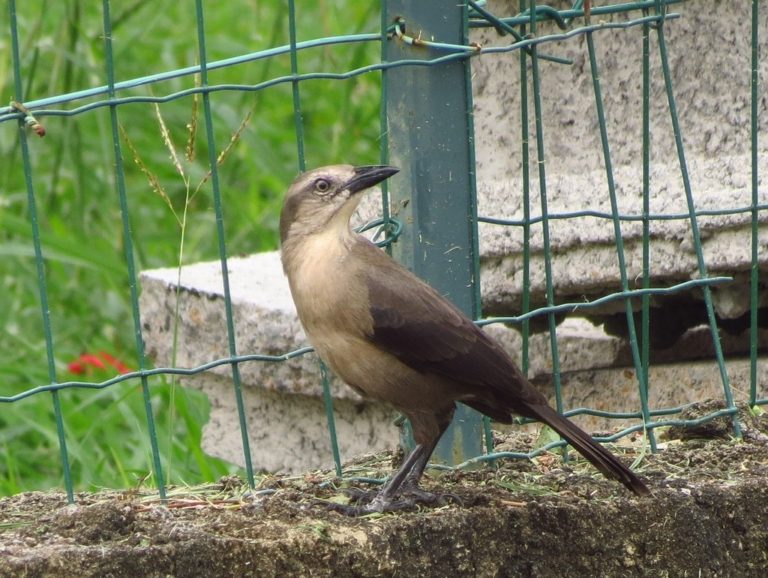
Carib Grackle, Q. l. guadeloupensis, female showing pale sandy underparts, prominent eyebrow, and dark-brown wings and tail. (Petite Anse, Martinique; January 14, 2016.) © Annika Lindqvist
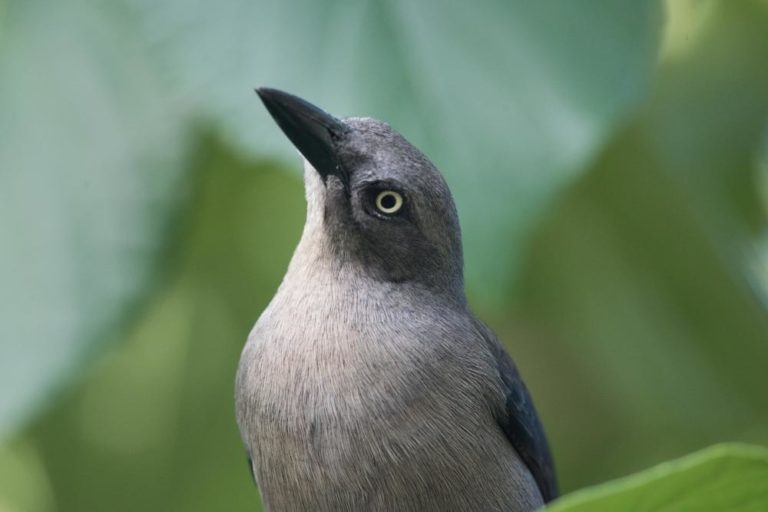
Carib Grackle, Q. l. guadeloupensis, female showing grayish coloration. (Sainte-Anne, Martinique; February 5, 2018.) © Erika Mitchell
Cf. Greater Antillean Grackle. Greater Antillean and Carib Grackles are not currently known to overlap, but both species are well adapted to human development, and the Carib Grackle’s range is expanding, so eventual contact between the two species seems likely. The male Carib is very similar to Greater Antillean (including the iridescence), but its tail is thinner and about 10-20% shorter. Female Caribs are variable shades of brown (blackish in “Barbados Grackle” and some gray in the northern Lesser Antilles) and therefore readily distinguished from the jet-black Greater Antillean females.
Notes
Polytypic species consisting of eight recognized subspecies, two of which have been regarded as a separate species or a distinct form, the “Barbados Grackle.”
References
Ascanio, D., G.A. Rodriguez, and R. Restall. 2017. Birds of Venezuela. Christopher Helm, London.
eBird. 2019. eBird: An online database of bird distribution and abundance. Cornell Lab of Ornithology, Ithaca, N.Y. http://www.ebird.org. (Accessed June 4, 2019.)
ffrench, R. 2012. A Guide to the Birds of Trinidad & Tobago (Third Edition). Cornell University Press, Ithaca, N.Y.
Fraga, R. 2019. Carib Grackle (Quiscalus lugubris). In Handbook of the Birds of the World Alive (J. del Hoyo, A. Elliott, J. Sargatal, D.A. Christie, and E. de Juana, eds.). Lynx Edicions, Barcelona. https://www.hbw.com/node/62285. (Accessed June 4, 2019.)
Jaramillo, A., and P. Burke. 1999. New World Blackbirds: The Icterids. Princeton University Press, Princeton, N.J.
McMullan, M., and T. Donegan. 2014, Field Guide to the Birds of Colombia (Second Edition). Fundación Proaves de Colombia, Bogotá.
Raffaele, H., J. Wiley, O. Garrido, A. Keith, and J. Raffaele. 1998. A Guide to the Birds of the West Indies. Princeton University Press, Princeton, N.J.
Ridgely, R.S., and G. Tudor. 2009. Field Guide to the Songbirds of South America: The Passerines. University of Texas Press, Austin.
van Perlo, B. 2009. A Field Guide to the Birds of Brazil. Oxford University Press, Oxford.
Wells, J.V., and A.C. Wells. 2017. Birds of Aruba, Bonaire, and Curaçao. Cornell University Press, Ithaca, N.Y.
Wikiaves, Iraúna-do-norte, http://www.wikiaves.com.br/irauna-do-norte.
